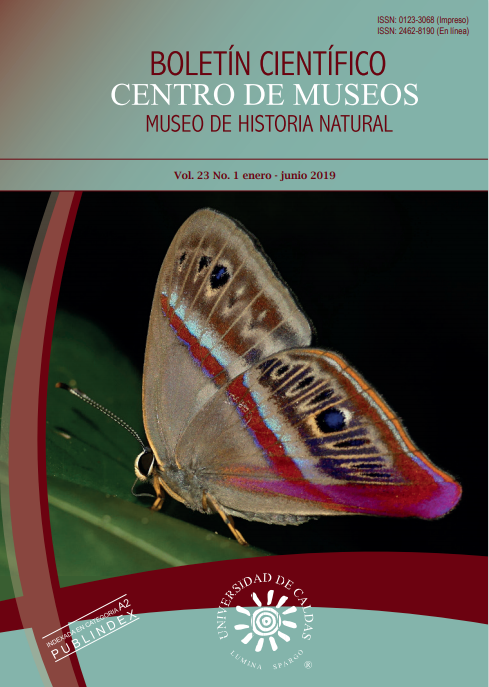Autores/as
Resumen
La obesidad es el aumento excesivo de tejido adiposo en el organismo y se considera una enfermedad que en las dos últimas décadas cerca del 50 % de la población canina a nivel mundial la padece. Objetivo: Aportar información científica sobre la prevalencia de la obesidad canina en Manizales e identificar algunos factores de riesgo. Metodología: Un estudio epidemiológico de caninos obesos fue realizado en el Hospital Veterinario Diego Villegas Toro de la ciudad de Manizales, departamento de Caldas, Colombia; 1060 casos se recolectaron de enero a junio de 2017. Se evaluó la condición corporal, en la escala del 1 al 9, para calificar el grado de obesidad. La condición corporal y el grado de obesidad fueron analizados respecto a raza, sexo y edad. Resultados: El 24,40 % de los caninos presentan algún grado de obesidad. Las razas más obesas son Beagle (57,14 %), Labrador (46 %) y Pinscher (27,03 %). Los perros adultos seguidos de los seniles son los más obesos. Existe asociación estadística entre la condición corporal y las variables raza (p=0,001) y edad (p=0,001), pero no entre la condición corporal y sexo (p=0,30). Se encontró asociación estadística de la obesidad con la raza (p=0,05), la edad (p=0,007) y el sexo (p=0,002). La prevalencia de la obesidad fue inferior a la reportada en
países como Estados Unidos, Francia, China y España. Conclusiones: La raza y la edad de los caninos son factores de riesgo para la presentación de la obesidad. Las razas Beagle, Labrador, Pinscher, Pitbull, Caniche y mestiza son las más susceptibles a padecer obesidad; al igual que los animales adultos, seguidos de los seniles. Es importante adelantar investigaciones sobre la prevalencia en otras regiones del país.
Palabras clave
Citas
BARTGES, J., KUSHNER, R.F., MICHEL, K.E., SALLIS, R. & DAY, M.J., 2017.- One Health Solutions to Obesity in People and Their Pets. J. Comp. Path., 156: 326-333.
BURKHOLDER, W.J. & BAUER, J.E., 1998.- Foods and techniques for managing obesity in companion animals. J. Am. Vet. Med. Assoc., 212(5): 658-662.
BURKHOLDER, W.J. & TOLL, P., 2000.- Obesity: 401-430 (en) HAND, M., THATCHER, C. & REMILLARD, R. (eds.) Small Animal Clinical Nutrition. Topeka: Mark Morris Institute.
BURKHOLDER, W.J. & TOLL, P., 1996.- Changes in body composition and energy balance with aging. Veterinary Clinical Nutrition, 3: 83-87.
CASSIDY, K.M., 2010.- Reported measures of how long dogs live. Dog longevity. Disponible en: https://sunsongdachshunds.wordpress.com/2010/12/13/dog-longevity/.
COLLIARD, L., ANCEL, J., BENET, J-J., PARAGON, B.M. & BLANCHARD, G., 2006.- Risk factors for obesity in dogs in France. The Journal of Nutrition, 136: 1951S-1954S.
CORBEE, R.J., 2013.- Obesity in show dogs. J. Anim. Physiol. Anim. Nutr., 97(5): 904-910.
CORTÉS, R.I., 2008.- Perfil epidemiológico de los caninos y felinos en tres clínicas veterinarias de Manizales: Tesis, Facultad de Medicina Veterinaria, Universidad de La Salle, Bogotá.
CRANE, S.W., 1991.- Occurrence and management of obesity in companion animals. J. Small Anim. Pract., 32: 275-282.
EDNEY, A.T. & SMITH, P.M., 1986.- Study of obesity in dogs visiting veterinary practices in the United Kingdom. Veterinary Record, 118: 391-396.
GERMAN, A.J., 2006.- The growing problem of obesity in dogs and cats. J. Nutr., 136: 1940S-1946S.
GERMAN, A.J., 2011.- Canine obesity weighing in the mind of the owner? J. Small Anim. Pract., 52: 619-620.
GERMAN, A.J., 2016.- Obesity Prevention and Weight Maintenance After Loss. Vet Clin Small Anim., 46(5): 913-929.
GONZÁLES, D.M. & BERNAL, L., 2011.- Diagnóstico y manejo de la obesidad en perros: una revisión. CES Medicina Veterinaria y Zootecnia, 6(2): 91-102.
JEUSETTE, I., GRECO, D., AQUINO, F., DETILLEUX, J., PETERSON, M. & ROMANO, V., et al., 2007.- Effect of breed on body composition and comparison between various methods to estimate body composition in dogs. Research Veterinary Science, 88(2): 227-232.
KEALY, R.D., LAWLER, D.F., BALLAM, J.M., MANTZ, S.L., BIERY, D.N. & GREELEY, E.H., et al., 2001.- Effects of diet restriction on life span age-related changes in dogs. Journal of the American Veterinary Medical Association, 220: 1315-1320.
MAO, J., ZHAOFEI, X., JIANGNAN, C. & JINHAI, Y., 2013.- Prevalence and risk factors for canine obesity surveyed in veterinary practices in Beijing, China. Preventive Veterinary Medicine, 112(3-4): 438-442.
LAFLAMME, D.P., 1997.- Development and Validation of a Body Condition Score System for Dogs. Canine Practice, 22(1): 10-15.
LAFLAMME, D.P., 2001.- Challenges with weight-reduction studies. Compend. Contin. Educ. Pract. Vet., 23: 45-50.
LUND, E.M., ARMSTRONG, P.J., KIRK, C.A. & KLAUSNER, J.S., 2006.- Prevalence and risk factors for obesity in adult dogs from private US veterinary practices. Intern. Journal. Appl. Res. Veterinary. Medicine, 4: 177-186.
MASON, E., 1970.- Obesity in pet dogs. Vet. Rec., 86: 612-616.
MCGREEVY, P.D., THOMSON, P.C., PRIDE, C., FAWCETT, A., GRASSI, T. & JONES, B., 2005.- Prevalence of obesity in dogs examined by Australian veterinary practices and the risk factors involved. The Veterinary Record, 156: 695-702.
MONTOYA-ALONSO, J.A., BAUTISTA-CASTAÑO, I., PEÑA, C., SUÁREZ, L., CANDELARIA JUSTE, M. & TVARIJONAVICIUTE, A., 2017.- Prevalence of Canine Obesity, Obesity-Related Metabolic Dysfunction, and Relationship with Owner Obesity in an Obesogenic Region of Spain. Front. Vet. Sci., 4: 59.
PARKER, H.G., KIM, L.V., SUTTER, N.B., CARLSON, S., LORENTZED, T.D. & MALEK, T.B., et al., 2004.- Genetic structure of the purebred domestic dog. Science, 304(5674): 1160-1164.
SCARLETT, J.M., DONOGHUE, S., SAIDLA, J. & WILLS, J., 1994.- Overweight cats: Prevalence and risk factors. International Journal of Obesity, 18(Suppl. 1): S22-S28.
SERVIDDIO, R., 2009.- Obesidad canina. Buenos Aires: Universidad Nacional de La Plata.
ZORAN, D.L., 2010.- Obesity in dogs and cats: A metabolic and endocrine disorder. Vet. Clin. North Am. Small Anim. Pract., 40: 221-239.

 PDF
PDF
 FLIP
FLIP























